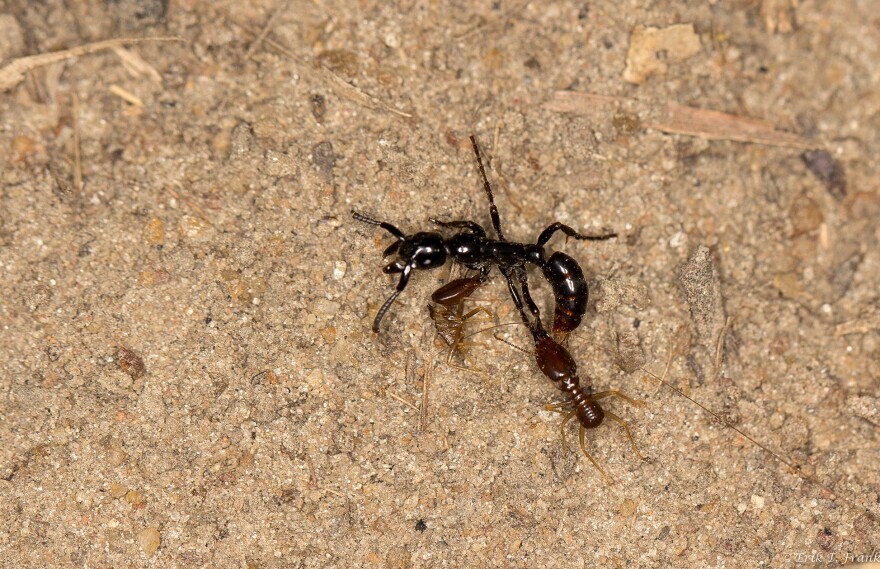Leave no man behind. That's an old idea in warfare — it's even part of the Soldier's Creed that Army recruits learn in basic training.
And never leaving a fallen comrade is also the rule for some warriors who are ants, according to a report published Wednesday in the journal Science Advances.
These ants, Megaponera analis, hunt and eat termites. Scouts will go out, find a group of termites, and then return to the ant nest to muster the troops.
Biologist Erik Frank explains that 200 to 500 ants will march out in formation. "Like three ants next to each other, in a 2-meter-long column," he says. "It's very peculiar and it looks like a long snake walking on the ground."
When the termites spot this invading army, they try to escape, but the fighting is fierce.
"And after roughly 20 minutes the battle is over," says Frank, a doctoral student with the University of Würzburg in Germany who is researching animal behavior and evolution. "You have a lot of termites lying dead on the ground," he says, "and the ants start collecting the termites to return."
A few years ago, Frank was working at a field station in the Ivory Coast when he noticed that some of the ants marching home after battle weren't carrying termites. Instead, they were carrying other ants.
"And I was wondering, 'What exactly was going on there? Why were they carrying some of the ants?'" he recalls.
It turns out, those transported ants weren't dead — they were injured.
Ants sometimes lose a leg or two, which makes it hard for them to walk. Or, they can be weighed down by a dead termite whose jaws had clamped onto them. Either way, they're slower than uninjured, unburdened ants.
By marking these injured ants with paint, Frank learned that in nearly all cases, they made a full recovery after being carried home to recuperate. They learn to walk with fewer legs, and their ant buddies apparently will pull off stuck termites. It doesn't take long for an ant that's been hurt to once again be ready for action.
"We saw them again, participating in hunts the next day," says Frank.
He and his colleagues did some experiments to see what would happen to injured ants that weren't carried home. It turns out that these poor ants couldn't march fast enough. So they fell behind — and frequently got eaten by spiders and other predators, the researchers report.
It's not so far-fetched, says Frank, to compare these ant rescue missions to those performed by human soldiers.
"One big difference I would say, though, is that these ants are not doing it out of the goodness of their heart," says Frank.
He says they're just responding to a chemical signal from the injured ants, rather than being motivated by empathy.
Peggy Mason, a neurobiologist at the University of Chicago who has studied how rats will rescue other rats from traps, says this is a great study that confirms that ants will rescue each other in certain situations.
"Does it remind me of mammalian helping? Well, not really," she says, noting that the ants don't seem to be intentionally helping each other.
"One reason why one might think that they're not is that if they encounter that same injured ant on the way to the hunt, they ignore it," Mason says. Wounded ants only get carried home if they're encountered after the battle.
Rats, in contrast, seem to have some sort of emotional response that triggers helping. Mason and her colleagues have found that giving rats an anti-anxiety drug seemed to take away their urge to release a distressed rat from a trap.
"None of them helped," she says. "They didn't help. They didn't see a problem."
It's clear that bringing injured warriors home has huge benefits for the ant colony.
"The number of ants that are saved by this behavior is about equivalent to the number of ants that are born each day in that colony." Mason says. "So they're making this substantial contribution to the ant colony through this rescue behavior. That's probably what drove this behavior to be selected for, and to evolve into a stable behavior."
After all, she notes, "this is an army. They're going off to attack the termites. It's a battle. And the more numerous you are, the more successful you are."
Copyright 2021 NPR. To see more, visit https://www.npr.org.






